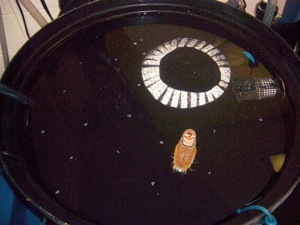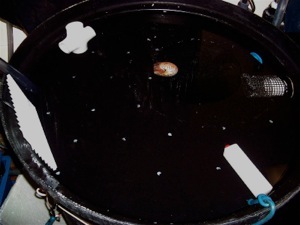Robyn Crook, PhD BSc
Evolutionary Biology, Animal Behavior, Neuroscience
Robyn Crook, PhD BSc
Evolutionary Biology, Animal Behavior, Neuroscience
How did cephalopods get so smart?
Learning and memory in Nautilus provide evolutionary clues
The cephalopods include octopuses, cuttlefish, squid, and nautilus. The soft-bodied cephalopods are known for their specialised brains and behaviours. Nautilus is a member of the more ancient subclass of cephalopods, and retains many ancestral features. Because its brain may be one of these ancient features it can provide us with interesting insights into the evolution of complex brains. I study learning and memory in nautiluses as a way of understanding how neural structures supporting memory may have evolved.
Nautilus has a simple ring-shaped brain like most molluscs. By contrast, all the other living cephalopods have brains that are much more complex. A crucial difference is the absence from the nautilus brain of two dedicated lobes that support learning and memory in all other cephalopods.
The relative simplicity of the nautilus brain may be ancestral or instead could be a secondary simplification; either hypothesis is plausible and is the subject of ongoing debate. Both possibilities hint at some interesting questions we can ask about nautilus behaviour: what are the advantages of having a vertical lobe vs. having less specialised learning structures? And how might selection on behaviour have shaped the divergent brains of the two subclasses of cephalopods?
Our research with nautilus revolves around several simple behavioural experiments. Because little is known about nautilus behaviour, we have developed our own techniques for training and testing our animals.



Mechanisms and functions of nociceptive sensitization in squid
Nociception, and pain (in animals capable of experiencing it) have important functions. Nociception allows animals to detect and avoid potentially injurious stimuli by making rapid changes to their behavior. Nociceptive sensitization may also help animals in the short and long term after injury, by driving modifications to their behaviours that help them avoid predators and promote healing. Both nociception and pain are powerful learning cues that help animals remember and avoid dangerous situations in the future.
My work on nociceptive sensitization focuses on gastropod and cephalopod molluscs. Gastropods have accessible sensory neurons that are well-suited to electrophysiological investigations, but tend to have simple behaviours that are not ideal for studying in ecological contexts. Cephalopods are among the most neurologically derived invertebrates, displaying impressive behavioural plasticity in learning and memory tests, and have complex defensive and anti-predation behaviours including camouflage (see top photo of two L. pealei squid camouflaging on a rocky bottom) and sequentially escalating escape behaviours, making them good subjects for behavioural studies.
Whether cephalopods can modify their anti-predator behaviours after injury is the focus of our current research. Together with Edgar Walters at the University of Texas, Houston, and Roger Hanlon at the Marine Biological Laboratory, I work on injury-related behavioural and neural plasticity in the squid. Our previous work (Crook et al., 2011) shows that squid make long-term changes to defensive behaviours after injury, and that these changes help them avoid predation in future.
We have also demonstrated that this generalised change in behavioural state might be driven by generalised sensitisation of nociceptors in squid. Unlike in mammals, where nociceptor sensitisation is restricted to the area close to a wound, in squid a minor injury to one fin produces long-term hyperexcitability of nociceptors not only on that same fin, but also on the opposite fin. This finding suggests some important differences in the way cephalopod brains process nociceptive inputs, and might also mean that any type of ‘pain’ experience is very different.
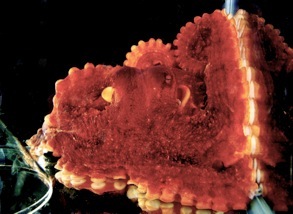
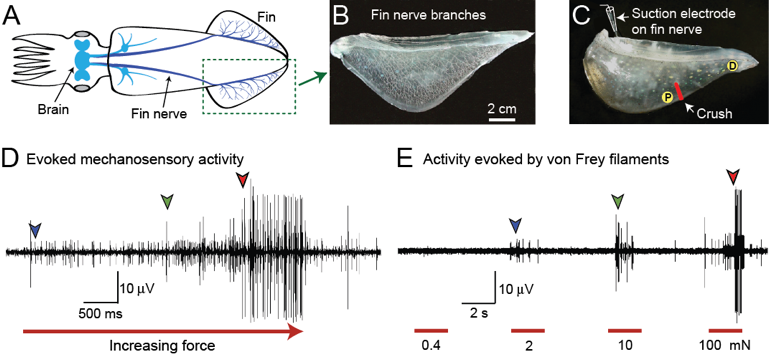
A description of primary nociceptor properties in squid. A The fin nerves run from the brain into each fin. B. Branches of the main fin nerve cover the entire fin. C. We can record from sensory neurons in the fin by placing a suction electrode on the whole fin nerve. D&E. Squid have low-threshold and high-threshold (nociceptive) mechanosensory neurons, but none that respond to noxious heat (not shown). From Crook et al., 2013.
g
In related experiments, we are examining how injury affects the excitability of nociceptors within and close to damaged tissue. We record from the fin nerve of Loligo while a minor injury (crush with fine forceps) is given to a distal edge of one fin. Both before and after crush, we record responses to a firm touch with a calibrated filament to areas around the crush site. After tissue injury there is pronounced short-term sensitisation of nearby sensory nerves that persists for at least 30 minutes after injury.
Sensitisation of primary nociceptors in squid. Left: A series of calibrated monofilaments applied to the fin before and after a minor crush injury to the fin margin shows strong short-term (30 minutes) sensitisation. Right: Fins injured 24h previously show not only sensitisation to touch but also an increase in rates of spontaneous firing. From Crook et al., 2013.
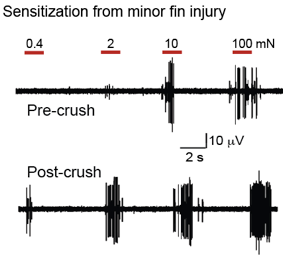
g
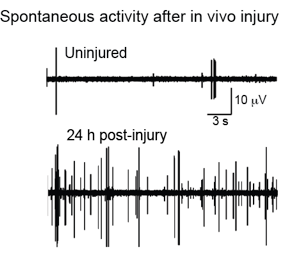
Classical conditioning in Chambered Nautilus. A blue light pulse (top left) is paired with an odour stimulus (green plume, mid right). Nautiluses respond by extending their tentacles, a behaviour which can be scored based on the degree of extension (bottom). Tests involving presentations of the light pulse without odour produced tentacle extension, indicating that an association between the stimuli had been learned. Modified from Crook and Basil, 2008.
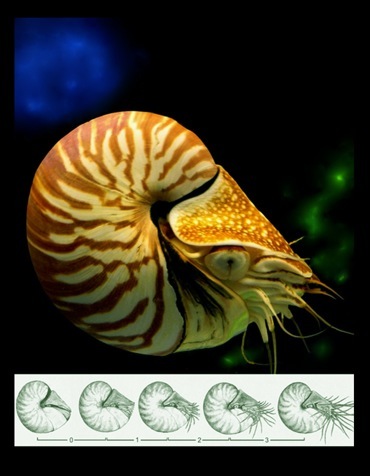
In these experiments (Crook and Basil, 2008) nautiluses were able to remember an association between a visual and an olfactory stimulus for both the short and long term. This two-phase memory was very similar to the way cuttlefish express associative memory, despite nautiluses having a brain, behaviors and ecology that are quite different. Because it is not clear whether nautilus brains contain a similar ‘memory centre’ to that of coleoids, this was surprising result. We hope to address the question of where memory is stored in nautilus brains in the future.
We have also shown that spatial memory (Crook et al., 2009; Crook and Basil 2013), is similar in nautilus and the other more derived cephalopods. Ongoing studies continue to expand on these behavioural techniques. We will look more closely at differences between what nautilus can learn and remember and what other cephalopods can learn and remember. This comparative approach helps us understand how the specialised memory centres in the brains of soft-bodied cephalopods help them learn so well.
Nautilus being tested for spatial memory. On the left, it must find the hole marked by the white stripes. On the right, it must locate the hole using distant landmarks around the edge of the tank. Described in Crook et al., 2009 and Crook and Basil, 2013.
